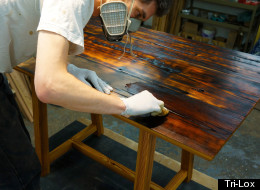
How do sustainable design organizations operate? Alexander Bender, co-founder of Brooklyn, NY workshop Tri-Lox, focuses on transforming reclaimed materials into furniture and architectural elements. Working with Ellis Isenberg and Tim Knight, the self-proclaimed "wood nerds" have funneled their sustainable building hobby into a business:
HuffPost Green: When did you first become interested in sustainable design?
Alexander Bender: Once I moved to NYC, I started to think about how things were made and what they were made out of. New York is such a pure built space. Every square inch of New York is considered, and touched by somebody's hands to be put to use.
I learned that there is a difference between demolition, which is just smashing the building and transporting the refuse to a landfill, and deconstruction, where original materials are salvaged. Deconstruction allows new things to be created without depleting our resources and wasting energy and usable materials.
Why do you care about sustainability?
The most important aspects of sustainable building are the environmental concerns. That said, sustainable design means having a relationship with and respect for your materials in a much deeper way. All of the wood we use has a story.
For example, we collected the remains of a 1720s house in Connecticut that partially burned down and needed to be deconstructed. It turned out that the majority of the wood we salvaged was American Chestnut, a species of wood that has nearly gone extinct in the United States. There are materials that you can really only get through the reclamation process, and so many types of rare materials end up discarded in landfills.
What is the hardest element of “going green”?
There's nothing easy about transporting, say, all of the remnants of a barn in Connecticut or a farmhouse in Upstate New York to our workshop. However, these are the materials that are the backbone of our whole philosophy, so it's a labor of love... and sweat equity.
What aspects of your work are not sustainable?
As we're working on developing an online store for our products, it immediately became apparent that there are not a lot of environmentally sustainable options for packing and shipping goods. As we prepare to expand our business to the online space, a major priority is to find packaging and shipping options that do not force us to depend on unsustainable materials.

What is the greatest struggle your organization has faced?
For all the amazing resources that New York City offers, it unfortunately is not terribly friendly to small businesses and start-ups. The laws in place really make the creation of a company a punitive experience, which is magnified for us by the fact that we require so many complex tools and so much space.
As we work towards doing more outreach in our community, we're hoping to also involve ourselves with small business advocacy groups. I think our country, and this city in particular, could be doing a lot more to support small businesses.
Could your approach be applied broadly, or do we need major furniture corporations as they currently operate, to meet demand?
We recognize that Tri-Lox handcrafts every element of what we build and, as such, we're working on smaller scale. However, there are numerous ways that larger furniture companies can adopt methods that make use of sustainable materials, recycled goods, and more robust designs.
The overarching idea here is to move away from a disposable economy of furniture and architecture that is designed to be used and discarded in a short amount of time; we need to value and understand the material world around us and not approach our possessions as disposable.
What upcoming plans do you have for Tri-Lox?
We are working with Build It Green!NYC and other non-profits and municipal organizations to install and operate a wood mill in Queens. When it's up and running (updates coming via Twitter), this mill will allow us to generate on our own high quality lumber from deconstructed sites and fallen trees from around NYC. We'll be able to take on more projects and therefore create jobs for local woodworkers, designers, and builders (an extremely talented and sorely underutilized workforce).
Ultimately, we want to establish a job training program that teaches sustainable methods and works towards the cultural shift previously mentioned.
In an ideal world, where will sustainable design be in 10 years?
We hope companies are held to a greater standard by a population that requires responsibility in how we use, and misuse, natural and human resources. There are so many ways that large and wealthy companies with enormous resources can utilize reclaimed materials and adopt greener practices, but we have to demand it of them.
